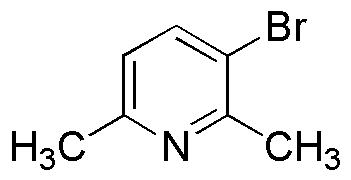3-Bromo-2,6-lutidine is widely utilized in research focused on:
- Synthesis of Pharmaceuticals: This compound serves as a key intermediate in the synthesis of various pharmaceutical agents, particularly in the development of anti-inflammatory and analgesic drugs.
- Organic Synthesis: It is used in organic chemistry for the synthesis of complex molecules, allowing researchers to create new compounds with desired properties efficiently.
- Ligand Development: In coordination chemistry, it acts as a ligand in the formation of metal complexes, which are essential in catalysis and materials science.
- Research in Agrochemicals: The compound is explored for its potential applications in developing agrochemicals, contributing to more effective pesticides and herbicides.
- Analytical Chemistry: It is utilized as a standard in analytical methods, helping researchers ensure the accuracy and reliability of their experimental results.
General Information
Properties
Safety and Regulations
Applications
3-Bromo-2,6-lutidine is widely utilized in research focused on:
- Synthesis of Pharmaceuticals: This compound serves as a key intermediate in the synthesis of various pharmaceutical agents, particularly in the development of anti-inflammatory and analgesic drugs.
- Organic Synthesis: It is used in organic chemistry for the synthesis of complex molecules, allowing researchers to create new compounds with desired properties efficiently.
- Ligand Development: In coordination chemistry, it acts as a ligand in the formation of metal complexes, which are essential in catalysis and materials science.
- Research in Agrochemicals: The compound is explored for its potential applications in developing agrochemicals, contributing to more effective pesticides and herbicides.
- Analytical Chemistry: It is utilized as a standard in analytical methods, helping researchers ensure the accuracy and reliability of their experimental results.
Documents
Safety Data Sheets (SDS)
The SDS provides comprehensive safety information on handling, storage, and disposal of the product.
Product Specification (PS)
The PS provides a comprehensive breakdown of the product’s properties, including chemical composition, physical state, purity, and storage requirements. It also details acceptable quality ranges and the product's intended applications.
Certificates of Analysis (COA)
Search for Certificates of Analysis (COA) by entering the products Lot Number. Lot and Batch Numbers can be found on a product’s label following the words ‘Lot’ or ‘Batch’.
*Catalog Number
*Lot Number
Certificates Of Origin (COO)
This COO confirms the country where the product was manufactured, and also details the materials and components used in it and whether it is derived from natural, synthetic, or other specific sources. This certificate may be required for customs, trade, and regulatory compliance.
*Catalog Number
*Lot Number
Safety Data Sheets (SDS)
The SDS provides comprehensive safety information on handling, storage, and disposal of the product.
DownloadProduct Specification (PS)
The PS provides a comprehensive breakdown of the product’s properties, including chemical composition, physical state, purity, and storage requirements. It also details acceptable quality ranges and the product's intended applications.
DownloadCertificates of Analysis (COA)
Search for Certificates of Analysis (COA) by entering the products Lot Number. Lot and Batch Numbers can be found on a product’s label following the words ‘Lot’ or ‘Batch’.
*Catalog Number
*Lot Number
Certificates Of Origin (COO)
This COO confirms the country where the product was manufactured, and also details the materials and components used in it and whether it is derived from natural, synthetic, or other specific sources. This certificate may be required for customs, trade, and regulatory compliance.


